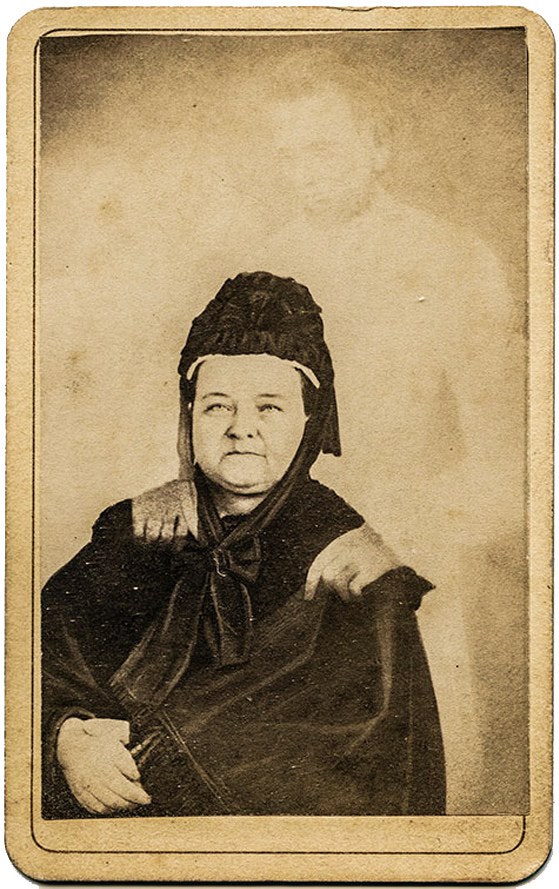The Picture of Abraham Lincoln’s Fake Ghost
On April 15, 1865, President Abraham Lincoln died, becoming the first American President to be assassinated. He left behind a grieving nation, still recovering from the Civil War, and also, a grieving widow, Mary Todd Lincoln. For the rest of her life, Mrs. Lincoln struggled with her husband’s death (and the subsequent loss of one of her sons in 1871), seeking solace wherever she could. And she wasn’t alone. The loss of the Civil War was still very new. Families across the United States felt that loss every day — empty chairs at dinner tables were a constant reminder of those loved ones lost in the field of battle.
At the same time these families were grieving, a new technology was emerging: photography. The first known photograph of a person was taken in 1838, but it was impractical for portrait photography due to the very long exposure time required. The value of photographs, though was clear, and many entrepreneurs and tinkerers set out to make photography more accessible to regular people. Some, though, were charlatans. Which is why the image below exists.

The picture above is of Mary Todd Lincoln and was most likely taken in 1869. And you’ll note immediately that there’s something strange about it. Two translucent hands are on her shoulders and she’s sitting rather low in the frame — there’s a lot of open space above her. Look close and you’ll see why: there’s a faint-but-clear image of a bearded man, dressed in white, standing behind Mary Todd. If you were inclined to believe it, you’d think that was Abraham Lincoln’s ghost comforting his widow.
Which is exactly the point.
The photograph was taken by a man named William H. Mumler, an amateur chemist and, ultimately, a professional photographer. As the University of Minnesota Press explains, “Mumler photographed ghosts—or so he claimed. Faint images of the dearly departed lurked in the background with the living, like his well-known photo of the recently assassinated Abraham Lincoln comforting Mary Todd [above]. The practice came to be known as spirit photography, and some believed Mumler was channeling the dead.”
For families looking to see evidence that a deceased love one was still with them, Mumler offered hope. As the History Channel explains, he held himself out as a regular photographer whose pictures, sometimes, showed more than what was visible in the room, but didn’t know why; “he was as astonished as everyone else that suddenly his camera could take pictures of ghosts.” For a fee, he’d take your picture, and maybe you’d get to see a ghost as well. But there was a caveat. Per History, “visitors to Mumler’s studio would be told that there’s no guarantee that a departed soul would appear.”
To modern ears, that sounds fishy, and as the U of M Press notes, many of Mumler’s contemporaries felt the same, calling his promise “a fraudulent trick on the gullible, taking advantage of the grieving at a time of suffering and loss.” Authorities in Mumler’s home state of Massachusetts agreed, and Mumler moved to New York to avoid prosecution. But that didn’t work. Prosecutors in New York brought charges against him and took him to trial for fraud. Per History, “the New York prosecutors called a parade of expert witnesses who offered at least nine ways that Mumler could have used photographic trickery to produce his ghostly images.” Even famed showman P.T. Barnum got in on the act; he commissioned a photograph of himself with the dead Mr. Lincoln to be used at trial as evidence of Mumler’s guilt.
While the prosecution was able to replicate the results of Mumler’s efforts, they weren’t able to demonstrate Mumler’s actual process; as a result, the judge in the trial found him not guilty. But the court of public opinion, mostly, ruled otherwise. Per the American Photography Museum, “hearing attracted nationwide attention, including the full cover page (and back-page cartoon ) of the mass-circulation Harper’s Weekly.” Mumler’s reputation diminished as few would hire him for a chance to be fooled, and he died in poverty in 1884. But the world will never know exactly how he pulled off his stunt — before he died, Mumler burned all of the negatives from the photographs he took, making it impossible for later generations to investigate his efforts.
Bonus fact: If a pet is named “Fido,” chances are it’s a dog; as the American Kennel Club asserts, “there’s no more clichéd name for a dog than Fido” and “when the word Fido is used today it’s usually as a slang reference to any dog.” And we have Abraham Lincoln to thank for that. Per the Kennel Club, while campaigning for the Presidency, Lincoln wanted to be seen as a man of the people, and as a result, he often appeared at campaign stops with his dog alongside him. The dog’s name was Fido, and, as the Kennel Club explains, “as Fido’s owner became the most famous man in America, ‘Fido’ caught on among dog owners and remained a popular name for generations to come.” (Lincoln’s Fido, though, met a fate similar to his owner’s; a few months after Abe was assassinated, Fido was killed by a knife-wielding drunkard.)
From the Archives: The Oldest Emoticon: Did Abraham Lincoln help create the :) face?
